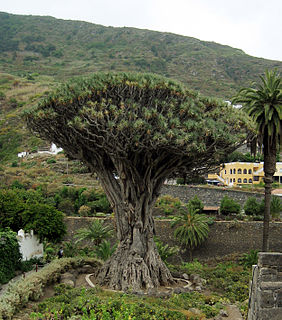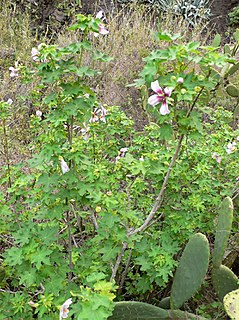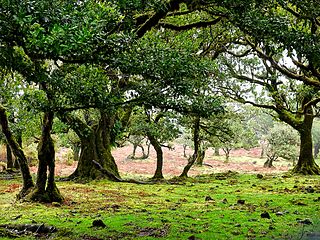
The common chaffinch or simply the chaffinch is a common and widespread small passerine bird in the finch family. The male is brightly coloured with a blue-grey cap and rust-red underparts. The female is more subdued in colouring, but both sexes have two contrasting white wing bars and white sides to the tail. The male bird has a strong voice and sings from exposed perches to attract a mate.

La Palma, also San Miguel de La Palma, is the most north-westerly island of the Canary Islands, Spain. La Palma has an area of 708 square kilometres (273 sq mi) making it the fifth largest of the eight main Canary Islands. The total population at the end of 2020 was 85,840, of which 15,716 lived in the capital, Santa Cruz de La Palma and about 20,467 in Los Llanos de Aridane. Its highest mountain is the Roque de los Muchachos, at 2,423 metres (7,949 ft), being second among the peaks of the Canaries only to the peaks of the Teide massif on Tenerife.

The grey wagtail is a member of the wagtail family, Motacillidae, measuring around 18–19 cm overall length. The species looks somewhat similar to the yellow wagtail but has the yellow on its underside restricted to the throat and vent. Breeding males have a black throat. The species is widely distributed, with several populations breeding in Eurosiberia and migrating to tropical regions in Asia and Africa. The species is always associated with running water when breeding, although they may use man-made structures near streams for the nest. Outside the breeding season, they may also be seen around lakes, coasts and other watery habitats. Like other wagtails, they frequently wag their tail and fly low with undulations and they have a sharp call that is often given in flight.

Pinus canariensis, the Canary Island pine, is a species of gymnosperm in the conifer family Pinaceae. It is a large, evergreen tree native and endemic to the outer Canary Islands in the Atlantic Ocean. It is a subtropical pine and does not tolerate low temperatures or hard frost, surviving temperatures down to about −6 to −10 °C. Within its natural area, it grows under extremely variable rainfall regimes, from less than 300 mm (12 in) to several thousands, mostly due to differences in mist-capturing by the foliage. Under warm conditions, this is one of the most drought-tolerant pines, living even with less than 200 mm (7.9 in) of rainfall per year. It is the vegetable symbol of the island of La Palma.

Dracaena draco, the Canary Islands dragon tree or drago, is a subtropical tree in the genus Dracaena, native to the Canary Islands, Cape Verde, Madeira, western Morocco, and is thought to be introduced in the Azores. It is the natural symbol of the island of Tenerife, together with the blue chaffinch. Its closest living relative is the dragon's blood tree of Socotra, Dracaena cinnabari.

Sonchus is a genus of flowering plants in the dandelion tribe within the sunflower family Asteraceae and are commonly known as sow thistles. Sowthistles are annual, biennial or perennial herbs, with or without rhizomes and a few are even woody.

Phoenix canariensis is a species of flowering plant in the palm family Arecaceae, native to the Canary Islands. It is a relative of Phoenix dactylifera, the true date palm. It is the natural symbol of the Canary Islands, together with the canary Serinus canaria. Mature P. canariensis are often used in ornamental landscaping and are collected and transplanted to their new planting location. A Canary Island date palm with 10 m (30 ft) of trunk is approximately 60 years of age.

The eastern Canary Islands chiffchaff or Lanzarote Island chiffchaff is an extinct subspecies of the Canary Islands chiffchaff endemic to the island of Lanzarote – and possibly also Fuerteventura – in the Canary Islands, Spain.

The Canary Islands chiffchaff is a species of leaf warbler endemic to the Canary Islands, Spain. Sometimes the English name is spelled Canary Island chiffchaff.

Quercus canariensis, the Mirbeck's oak, zean oak or Tash't oak as they call it in Morocco and Algeria, is an oak in the section Quercus sect. Mesobalanus, native to southern Portugal, Spain, Morocco, Algeria and Tunisia. Despite the scientific name, it does not occur naturally today in the Canary Islands, though it may have in the past.

Sonchus oleraceus is a species of flowering plant in the dandelion tribe Cichorieae of the daisy family Asteraceae, native to Europe and Western Asia. It has many common names including common sowthistle, sow thistle, smooth sow thistle, annual sow thistle, hare's colwort, hare's thistle, milky tassel, milk thistle. and soft thistle.

Malva acerifolia, also frequently known under the synonyms Lavatera acerifolia or Malva canariensis is a shrub endemic to the Canary Islands, belonging to the family Malvaceae.

Ilex canariensis, the small-leaved holly, is an endemic species of holly native to Macaronesian islands. It is a species of plant in the family Aquifoliaceae. It is found in the Macaronesian islands of Madeira (Portugal) and Canary Islands (Spain).

Euphorbia canariensis, commonly known as the Canary Island spurge, Hercules club or in Spanish cardón, is a succulent member of the genus Euphorbia and family Euphorbiaceae endemic to the Canary Islands. It is the plant symbol of the island of Gran Canaria.

The La Palma chaffinch, also known as the Palman chaffinch or, locally in Spanish as the pinzón palmero or pinzón hembra, is a small passerine bird in the finch family Fringillidae. It is a subspecies of the common chaffinch that is endemic to La Palma in the Canary Islands, a Spanish archipelago that forms part of Macaronesia in the North Atlantic Ocean.

Canarina canariensis is a species of flowering plant in the bellflower family Campanulaceae, commonly known as the Canary Island bellflower, and known locally as bicácaro.

Davallia canariensis, the hare's-foot fern, is a species of fern in the family Davalliaceae. It is endemic to Macaronesia and the Iberian Peninsula. It grows well in a sunny atmosphere and amongst rocks.
Cistus chinamadensis is a shrubby species of flowering plant in the family Cistaceae, with purple-pink flowers, first described in 1991. It is endemic to the Canary Islands, where three subspecies occur on three separate islands. The species has been assessed as endangered in the IUCN Red List, being known only from small separated areas and facing a variety of threats.

Salix pedicellata is a species of willow. It is a shrub or small tree to about 6–8 m tall, native around the Mediterranean Sea from Portugal to Lebanon and Syria in the north and from the Canary Islands to Tunisia in the south. Salix canariensis may be treated as a subspecies of S. pedicellata.

The Madeira evergreen forests is a temperate broadleaf and mixed forests ecoregion of southwestern Europe. It covers the archipelago of Madeira and some nearby islands in the Atlantic Ocean. Laurel forest, known as laurissilva, once covered the islands. Over centuries the forests were mostly cleared. Madeira's remaining forests are now protected.


















